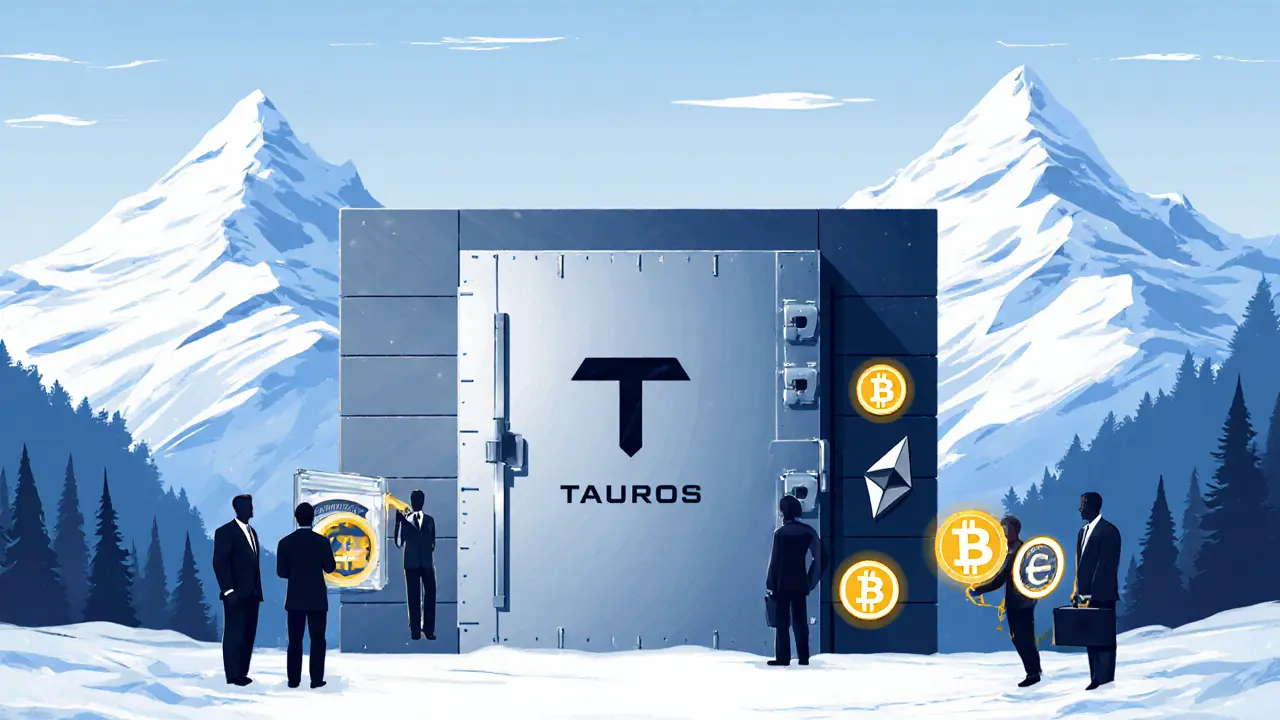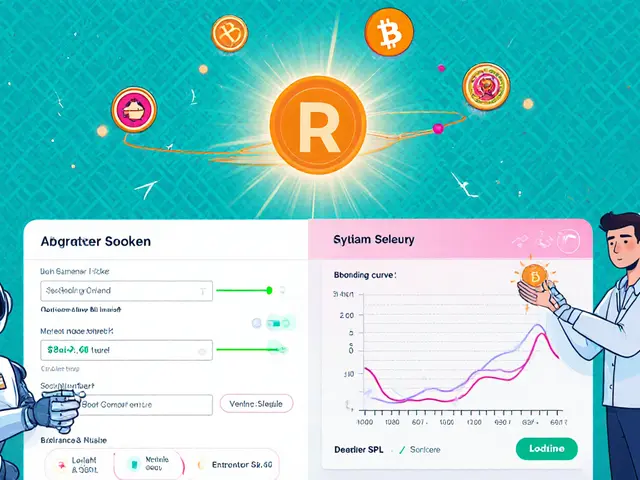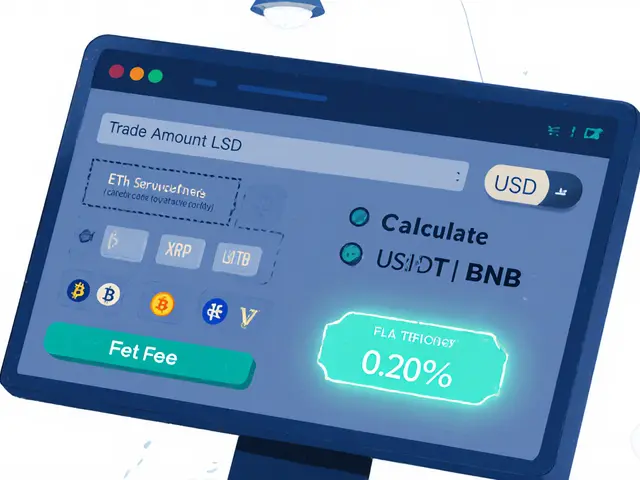- Home
- ::
- Tauros Crypto Exchange Review - Institutional Custody Platform Explained

Tauros Crypto Exchange Review - Institutional Custody Platform Explained
Tauros vs. Retail Exchanges Comparison Tool
Compare Features
Select an exchange type to see how Tauros compares in terms of security, compliance, and functionality.
Feature Comparison
| Feature | Current Selection | Alternative |
|---|---|---|
| Primary Audience | ||
| Trading Interface | ||
| Security Model | ||
| Regulatory Compliance | ||
| Tokenization Support | ||
| Fee Structure |
Security Comparison
Dual-key + HSM + MPC
Hot wallets, 2FA
Quick Take
- Tauros isn’t a retail‑focused exchange; it’s a Swiss‑based Taurus crypto custody service for institutions.
- It uses dual‑key, hardware‑security‑module (HSM) architecture and multi‑party computation for ultra‑secure storage.
- Partnerships with DeutscheBank and Elliptic give it deep compliance and market‑access muscle.
- Compared with Binance or Coinbase, Tauros offers no trading UI - it’s built for custody, tokenization, and regulatory reporting.
- Best suited for banks, asset managers, and crypto‑native funds that need provable security and auditability.
What Tauros Actually Is
When you search for “Tauros crypto exchange,” the first thing you’ll notice is that Tauros doesn’t operate a public order‑book or a mobile trading app. Instead, the platform - officially known as Taurus is a Swiss‑registered custody and tokenization service designed for institutional investors - provides a secure vault for digital assets and a framework to issue tokenized securities.
Founded in 2020 and headquartered in Switzerland, a jurisdiction renowned for banking privacy and robust data‑center standards, Taurus positions itself as a bridge between legacy finance and blockchain. Its tagline, “Digital assets, institutional grade,” captures the core promise: give banks the same level of control they have over cash, but for crypto.
Technical Architecture and Security Backbone
Security is the linchpin of any custody solution, and Taurus leans on a multi‑layered design that would feel familiar to a traditional bank’s vault manager.
- Dual‑key authorization: Every blockchain transaction must be signed by two independent keys - a hot signing key and a cold master key stored in an air‑gapped environment.
- Keys reside inside Hardware Security Modules (HSMs), certified to TierIII/IV datacenter standards and audited under ISAE3402. The HSMs generate, store, and protect master keys in a non‑extractable fashion.
- Multi‑party computation (MPC) for critical actions such as smart‑contract upgrades. Instead of a single point of failure, the platform requires a quorum of hardware‑token‑backed operators to approve changes.
- All hot operations run in a hardened Linux environment with continuous monitoring, while cold‑key activities are executed on an air‑gapped workstation that never connects to the internet.
- Disaster‑recovery drills are performed quarterly, simulating data‑center failover and key‑recovery scenarios.
In plain language, if a hacker compromised one machine, they still couldn’t move assets without the second key or the physical hardware token - a set‑up that mirrors the “two‑person rule” used in high‑value cash handling.
Compliance, AML, and Regulatory Partnerships
Institutional investors can’t ignore regulatory risk. Taurus tackles this head‑on with two major collaborations.
- Elliptic provides real‑time blockchain analytics, flagging suspicious transactions against a database covering 99% of market‑cap crypto assets. The integration automatically freezes or reports high‑risk flows, helping clients stay AML‑compliant.
- The platform works closely with the German Federal Financial Supervisory Authority (BaFin) to align its custody licence with European banking standards. This partnership smooths the path for banks like DeutscheBank that have announced a rollout of Taurus‑powered digital‑asset services for their corporate clients.
Beyond AML, Taurus undergoes at least ten third‑party security assessments per year, ranging from penetration testing to formal code audits. All findings are shared with clients, giving them full visibility into the platform’s risk posture.

Institutional Adoption - Who’s Using Taurus?
While retail traders won’t find a Tauros app on the App Store, several heavyweight financial institutions have signed up.
- DeutscheBank plans to integrate Taurus’s custody engine into its “Digital Asset Desk,” allowing German corporates to hold Bitcoin, Ether, and tokenized securities under bank‑grade protection.
- European asset managers are leveraging Taurus’s tokenization framework to issue regulated security tokens backed by real‑world assets such as real‑estate and corporate bonds.
- Crypto‑native hedge funds cite Taurus’s audit‑ready reporting and its ability to generate proof‑of‑reserves as a decisive factor for onboarding.
In short, the platform’s client roster reads more like a list of banks than a community of meme‑coin enthusiasts.
How Taurus Differs From a Traditional Crypto Exchange
To help you decide whether Tauros meets your needs, here’s a side‑by‑side look at the most common retail exchanges (Binance, Coinbase) versus the Taurus platform.
| Feature | Retail Exchanges (Binance, Coinbase) | Taurus (Custody & Tokenization) |
|---|---|---|
| Primary audience | Retail traders, small‑to‑mid sized investors | Institutional investors, banks, asset managers |
| Trading UI | Web/mobile apps with order books, charts, margin | None - API‑first custody & token‑issuance services |
| Security model | Hot wallets, 2FA, optional hardware wallets | Dual‑key + HSM + MPC, audited cold‑key storage |
| Regulatory compliance | Varies by jurisdiction, KYC/AML basics | Integrated AML via Elliptic, BaFin‑aligned licensing, audit‑ready reports |
| Tokenization support | Limited - usually only native assets | Full framework for issuing compliant security tokens |
| Fee structure | Percentage of trade volume, withdrawal fees | Custody fees per asset (bps), token‑issuance fees, no trading commissions |
If you’re looking to place a trade, Binance or Coinbase will serve you better. If you need provable, regulator‑approved safekeeping of large crypto balances, Taurus is built for that purpose.
Pros, Cons, and Ideal Use Cases
Pros
- Bank‑grade security with dual‑key, HSM, and MPC.
- Integrated AML analytics from Elliptic.
- Regulatory alignment with BaFin and European banking standards.
- Scalable tokenization engine for security tokens.
- Transparent third‑party audit reports shared with clients.
Cons
- No retail trading interface - not a conventional exchange.
- Onboarding requires institutional KYC, which can be time‑consuming.
- Pricing is asset‑based and may be higher than low‑fee retail exchanges.
- Limited public documentation; most details are shared under NDA.
Best fit
- Large banks expanding into digital assets.
- Asset managers launching tokenized fund structures.
- Crypto hedge funds needing audited custody and proof‑of‑reserves.
- Regulated entities that cannot rely on self‑custody solutions.
Frequently Asked Questions
Is Tauros a real exchange where I can buy Bitcoin?
No. Tauros (actually Taurus) does not provide a public order‑book or a trading app. It is a custody and tokenization service aimed at institutions, not a retail exchange.
Can a small crypto startup use Taurus for custody?
The platform primarily onboards regulated entities. While a startup could apply, it must meet strict KYC/AML standards and typically needs a legal entity that complies with European financial regulations.
What assets does Taurus support?
Hundreds of cryptocurrencies and tokenized securities are supported, including Bitcoin, Ether, stablecoins, and custom ERC‑20 security tokens. The exact list is provided in the client’s API documentation.
How does the dual‑key system work in practice?
When a withdrawal is requested, the hot signing key signs the transaction in a secure server. The master key, stored offline in an HSM, must also sign before the transaction is broadcast. Both signatures are required, preventing a single point of compromise.
Is there a way to prove that Taurus actually holds my assets?
Yes. Taurus provides cryptographic proof‑of‑reserves and audit‑ready reports that can be shared with regulators or auditors on demand.
Next Steps for Interested Institutions
If your organization fits the institutional profile, here’s a quick roadmap:
- Contact Taurus’s sales team for a tailored onboarding questionnaire.
- Prepare regulatory documentation (KYC, AML policies, legal entity registration in the EU).
- Complete the technical integration - usually via a REST API and secure VPN access to the custody hub.
- Run a pilot with a small asset slice (e.g., 10BTC) to validate workflow and reporting.
- Scale up to full‑portfolio custody and, if needed, launch tokenized securities through the same platform.
Remember, the value of Taurus lies not in cheap trades but in the peace of mind that comes from bank‑grade security and compliant token issuance.


 Finance
Finance





Write a comment